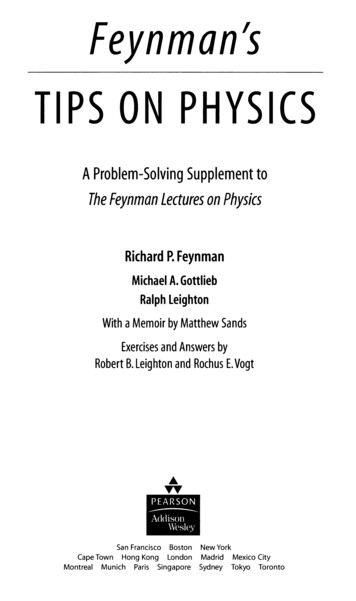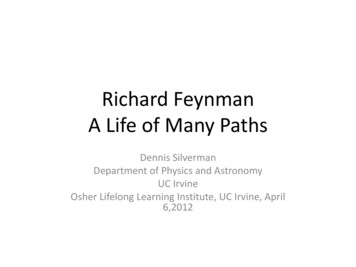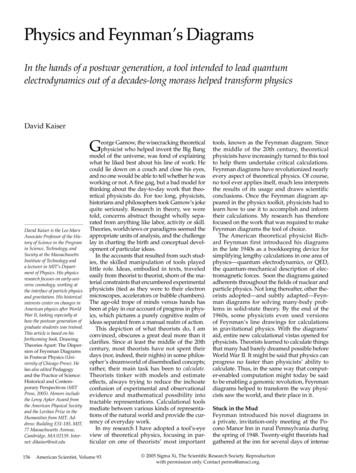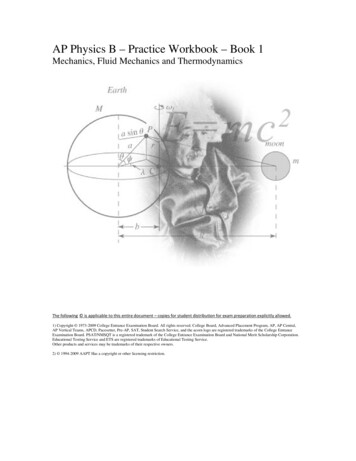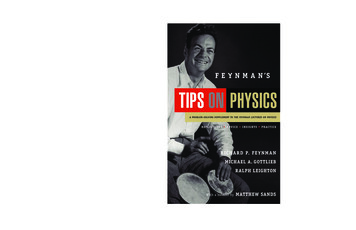
Transcription
Feynman’s Tips on Physics is a delightful collectionof Richard P. Feynman’s insights and an essential companionto his legendary Feynman Lectures on Physics .With characteristic flair, insight, and humor, Feynman discusses topics physics studentsoften struggle with and offers valuable tips on addressing them. Included here are threeFeynman Gottlieb LeightonScienceFE Y N M A N ’Slectures on problem-solving and a lecture on inertial guidance omitted from The FeynmanLectures on Physics. An enlightening memoir by Matthew Sands and oral history interviews withlandmark lecture series. Also included are incisive and illuminating exercises originally developedto supplement The Feynman Lectures on Physics, by Robert B. Leighton and Rochus E. Vogt.Feynman’s Tips on Physics was co-authored by Michael A. Gottlieb and Ralph Leighton toprovide students, teachers, and enthusiasts alike an opportunity to learn physics from some of itsgreatest teachers, the creators of The Feynman Lectures on Physics.Richard P. Feynman was a Professor of Physics at the California Institute of Technology from1951 to 1988. He shared the 1965 Nobel Prize in Physics for his work on quantum electrodynamics.Michael A. Gottlieb is a Visitor in Physics at the California Institute of Technology who,with Rudolf Pfeiffer, created and maintains the LaTeX manuscript used to produce the presentand future editions of The Feynman Lectures on Physics and the forthcoming Exercises for theFeynman Lectures on Physics. Ralph Leighton is an author, lateral thinker, and long-timeFEYNMAN’S TIPS ON PHYSICSFeynman and his Caltech colleagues provide firsthand accounts of the origins of Feynman’sTIPS ON PHYSICSA Problem-Solvingon tPhysicsR e f l e c t i oSupplementn s A d v itoc eThe FeynmanI n s i g h tLecturess P raciceR e f l e c t i o n s A d v i c e I n s i g h t s P rac t i c e5.5 X 8.25S: 9/16 EBASICPBRICHAR D P. FEY NM ANMICHAEL A. GOTTLIEBfriend of the late Richard Feynman.w w w. f e y n ma n l e c t u r e s . i n f oPhotograph courtesy of Ralph LeightonrALPH LEIGHTON 16.99 US / 19.99 CANISBN 978-0-465-02797-251699A Member of the Perseus Books Groupwww.basicbooks.com9 780465 027972With a memoir bymatthew sands4COLORFINISH:Gritty Matte
0465027972-Feynman Layout 1 11/12/12 12:08 PM Page iFeynman’s Tips on Physics
0465027972-Feynman Layout 1 11/12/12 12:08 PM Page iiA L S O B Y R I C H A R D P. F E Y N M A NThe Feynman Lectures on Physics(with Robert B. Leighton and Matthew Sands)Exercises for The Feynman Lectures on Physics(with Robert B. Leighton, Matthew Sands and Rochus Vogt;edited by Michael A. Gottlieb and Rudolph Pfeiffer)Six Easy Pieces: Essentials of PhysicsExplained by its Most Brilliant Teacher(Six lectures from The Feynman Lectures on Physics)Six Not-So-Easy Pieces:Einstein’s Relativity, Symmetry, and Space-Time(Six additional lectures from The Feynman Lectures on Physics)The Character of Physical LawQED: The Strange Theory of Light and MatterElementary Particles and the Laws of Physics(with Steven Weinberg)Feynman Lectures on Computation(edited by Anthony J. G. Hey and Robin Allen)The Meaning of It All: Thoughts of a Citizen-ScientistThe Pleasure of Finding Things Out:The Best Short Works of Richard P. FeynmanPerfectly Reasonable Deviations from the Beaten Track:The Letters of Richard P. Feynman(edited by Michelle Feynman)Surely You’re Joking, Mr. Feynman!Adventures of a Curious Character(with Ralph Leighton)What Do You Care What Other People Think?Further Adventures of a Curious Character(with Ralph Leighton)Classic Feynman:All the Adventures of a Curious Character(The two previous books combined, edited by Ralph Leighton)
0465027972-Feynman Layout 1 11/12/12 12:08 PM Page iiiFEYNMAN’STIPSonPHYSICSREFLECTIONS ADVICE INSIGHTS PRACTICEA problem-solving supplement toThe Feynman Lectures on PhysicsRichard P. FeynmanMichael A. GottliebRalph LeightonWith a memoir byMatthew SandsA M EM BER O F T H E P E R S E U S B O O K S G R O U PNew York
0465027972-Feynman Layout 1 11/12/12 12:08 PM Page ivCopyright 2013 by Carl Feynman, Michelle Feynman, Michael A. Gottlieb,Ralph LeightonPublished by Basic Books,A Member of the Perseus Books GroupAll rights reserved. Printed in the United States of America. No part of this bookmay be reproduced in any manner whatsoever without written permission exceptin the case of brief quotations embodied in critical articles and reviews. Forinformation, address Basic Books, 250 West 57th Street, 15th Floor, New York,NY, 10107.Books published by Basic Books are available at special discounts for bulkpurchases in the United States by corporations, institutions, and otherorganizations. For more information, please contact the Special MarketsDepartment at the Perseus Books Group, 2300 Chestnut Street, Suite 200,Philadelphia, PA 19103, or call (800) 810-4145, ext. 5000, or e-mailspecial.markets@perseusbooks.com.A CIP catalog record for this book is available from the Library of Congress.LCCN: 2011944291ISBN: 978-0-465-02797-2 (paperback)ISBN: 978-0-465-02921-1 (e-book)10 9 8 7 6 5 4 3 2 1
0465027972-Feynman Layout 1 11/12/12 12:08 PM Page vContentsPreface to the Second Edition, viiForeword, ixIntroduction, xiAcknowledgments, xvOn the Origins of The Feynman Lectures on Physics,A Memoir by Matthew Sands 1Interview with Richard Feynman 15Interview with Robert Leighton 23Interview with Rochus Vogt 2912345Prerequisites—Review Lecture A 35Laws and Intuition—Review Lecture B 61Problems and Solutions—Review Lecture C 91Dynamical Effects and Their Applications 115Selected Exercises 155Photo Credits, 179Index, 181
0465027972-Feynman Layout 1 11/12/12 12:08 PM Page vi
0465027972-Feynman Layout 1 11/12/12 12:08 PM Page viiPreface to the Second EditionIn the six years since the initial publication of Feynman’s Tips on Physics(Addison-Wesley, 2006) interest in this supplement to The Feynman Lectures on Physics has continued unabated, as evidenced by the ever-increasing number of visitors to The Feynman Lectures Website (www.feynmanlectures.info), created in conjunction with this project: thousands ofinquiries have come in, many of them reporting suspected errata in TheFeynman Lectures, and many with questions and comments about physicsexercises.It is thus with great pleasure and pride we present this second edition ofFeynman’s Tips on Physics, published by Basic Books as part of a unification of print, audio, and photo rights pertaining to The Feynman Lectureson Physics—rights which had been assigned over the years to different publishers. To celebrate this fortuitous occasion, The Feynman Lectures onPhysics (New Millennium Edition) is now being printed for the first timefrom a LaTeX manuscript, thus enabling errata to be corrected much morequickly, and electronic editions of The Lectures to be produced soon. In addition, this new edition of Feynman’s Tips on Physics is being made available in softcover at a greatly reduced price from the hardcover original, andexpanded to include three insightful interviews about The Lectures: with Richard Feynman, in 1966, soon after his key part in the projectwas finished, with Robert Leighton, in 1986, about Feynman’s gifts as a lecturer—and the challenges of translating from “Feynmanese” into English, and with Rochus Vogt, in 2009, about the community of professors thatcooperatively taught The Feynman Lectures course at Caltech.To all of you who e-mailed or posted questions and comments about TheFeynman Lectures on Physics and Feynman’s Tips on Physics, we wish tooffer our heartfelt thanks; your contributions and support have helped greatlyto improve these books, and will be appreciated by future generations ofreaders. To those who wrote requesting more exercises, we apologize thatthey could not be included in this edition. However, your encouragementhas inspired the creation of a new, expansive (soon-to-be-published) book,Exercises for The Feynman Lectures on Physics.Michael A. GottliebRalph LeightonNovember 2012
0465027972-Feynman Layout 1 11/12/12 12:08 PM Page viii
0465027972-Feynman Layout 1 11/12/12 12:09 PM Page ixForewordAt a lonely border post high on the Himalayan frontier, RamaswamyBalasubramanian peered through his binoculars at the People’s LiberationArmy soldiers stationed in Tibet—who were peering through their scopesback at him. Tensions between India and China had been high for severalyears since 1962, when the two countries traded shots across their disputedborder. The PLA soldiers, knowing they were being watched, tauntedBalasubramanian and his fellow Indian soldiers by shaking, defiantly, highin the air, their pocket-sized, bright-red copies of Quotations fromChairman Mao—better known in the West as “Mao’s Little Red Book.”Balasubramanian, then a conscript studying physics in his spare time,soon grew tired of these taunts. So one day, he came to his observation postprepared with a suitable rejoinder. As soon as the PLA soldiers started waving Mao’s Little Red Book in the air again, he and two fellow Indian soldiers picked up and held aloft the three big, bright-red volumes of TheFeynman Lectures on Physics.One day I received a letter from Mr. Balasubramanian. His was amonghundreds of letters I have received over the years that describe the lastingimpact Richard Feynman has had on people’s lives. After recounting the“red-books” incident on the Sino-Indian frontier, he wrote: “Now, twentyyears later, whose red books are still being read?”Indeed. Today, more than forty years after they were delivered, TheFeynman Lectures on Physics are still being read—and still inspire—evenin Tibet, I suspect.A special case in point: several years ago I met Michael Gottlieb at aparty where the host was displaying on a computer screen the harmonicovertones of a live Tuvan throat-singer—the kind of event that makes living in San Francisco such fun. Gottlieb had studied math and was veryinterested in physics, so I suggested he read The Feynman Lectures onPhysics—and about a year later, he devoted six months of his life to reading The Lectures very carefully from beginning to end. As Gottliebdescribes in his introduFtion, this led, eventually, to the book you are reading now, as well as to a new, “Definitive Edition” of The Feynman Lectureson Physics.
0465027972-Feynman Layout 1 11/12/12 12:09 PM Page xx FOREWORDThus I am pleased that people interested in physics all over the world cannow study, with the addition of this supplemental volume, a more correctand complete edition of The Feynman Lectures on Physics—a monumentalwork that will continue to inform and inspire students for decades to come,whether in midtown Manhattan or high in the Himalayas.Ralph LeightonMay 11, 2005
0465027972-Feynman Layout 1 11/12/12 12:16 PM Page xiRichard Feynman, circa 1962IntroductionI first heard of Richard Feynman and Ralph Leighton in 1986, through theirentertaining book Surely You’re Joking, Mr. Feynman! Thirteen years laterI met Ralph at a party. We became friends, and over the next year we workedtogether on the design of a fantasy stamp honoring Feynman.1 All the whileRalph was giving me books to read, by or about Feynman, including (sinceI am a computer programmer) Feynman Lectures on Computation.2 Thediscussion of quantum mechanical computation in this fascinating bookintrigued me, but without having studied quantum mechanics, I had difficulty following the arguments. Ralph recommended I read The FeynmanLectures on Physics Volume III: Quantum Mechanics, which I began, butChapters 1 and 2 of Volume III are reproduced from Chapters 37 and 38 ofVolume I, so I found myself backtracking through references in Volume Irather than progressing through Volume III. I therefore decided to read allThe Feynman Lectures from beginning to end—I was determined to learnsome quantum mechanics! However, that goal became secondary as time1Our stamp appears in the liner notes of Back TUVA Future, a CD featuring the Tuvanthroat-singing master Ondar and a cameo appearance by Richard Feynman (WarnerBros. 9 47131-2), released in 1999.2Feynman Lectures on Computation, by Richard P. Feynman, edited by Anthony J.G.Hey and Robin W. Allen, 1996, Addison-Wesley, ISBN 0-201-48991-0.
0465027972-Feynman Layout 1 11/12/12 12:16 PM Page xiixii INTRODUCTIONwent on and I became increasingly absorbed in Feynman’s fascinatingworld. The joy of learning physics, simply for the pleasure of it, became myhighest priority. I was hooked! About halfway through Volume I, I took abreak from programming and spent six months in rural Costa Rica studying The Lectures full-time.Every afternoon I studied a new lecture and worked on physics problems; in the mornings I reviewed and proofread yesterday’s lecture. I wasin e-mail contact with Ralph, and he encouraged me to keep track of errorsI mentioned encountering in Volume I. It was not much of a burden, becausethere were very few errors in that volume. However, as I progressedthrough Volumes II and III, I was dismayed to discover increasingly moreerrors. In the end I had compiled a total of more than 170 errors in TheLectures. Ralph and I were surprised: how could so many errors have beenoverlooked for so long? We decided to see what could be done about getting them corrected in the next edition.Then I noticed some intriguing sentences in Feynman’s preface:“The reason there are no lectures on how to solve problems is becausethere were recitation sections. Although I did put in three lectures in thefirst year on how to solve problems, they are not included here. Also therewas a lecture on inertial guidance which certainly belongs after the lectureon rotating systems, but which was, unfortunately, omitted.”This suggested the idea of reconstructing the missing lectures and, ifthey proved interesting, offering them to Caltech and Addison-Wesley forinclusion in a more complete and error-corrected edition of The Lectures.But first I had to find the missing lectures, and I was still in Costa Rica!Through a bit of deductive logic and investigation, Ralph was able to locatethe lecture notes, which were previously hidden away somewhere betweenhis father’s office and the Caltech Archives. Ralph also obtained taperecordings of the missing lectures, and while researching errata in theArchives after my return to California, I fortuitously discovered the blackboard photos (long believed lost) in a box of miscellaneous negatives. TheFeynman heirs generously gave us permission to use these materials, andso, with some useful critiques from Matt Sands, now the only survivingmember of the Feynman-Leighton-Sands trio, Ralph and I reconstructedReview B as a sample, and presented it with the errata for The Lectures toCaltech and Addison-Wesley.Addison-Wesley received our ideas enthusiastically, but Caltech wasinitially skeptical. Ralph therefore appealed to Kip Thorne, the RichardFeynman Professor of Theoretical Physics at Caltech, who eventually managed to achieve a mutual understanding among all involved, and who generously volunteered his time to oversee our work. Since Caltech did not want
0465027972-Feynman Layout 1 11/12/12 12:16 PM Page xiiiINTRODUCTION xiiito amend the existing volumes of The Lectures for historical reasons, Ralphproposed putting the missing lectures in a separate book. That is the originof this supplementary volume. It is being published in parallel with a newDefinitive Edition of The Feynman Lectures on Physics, in which the errorsI found are corrected, as are other errors found by a number of other readers.Matt Sands’ memoirIn our quest to reconstruct the four lectures, Ralph and I had many questions. We felt very fortunate to be able to get answers from Professor MattSands, the man whose idea it was to embark on the ambitious project thatproduced The Feynman Lectures on Physics. We were surprised that thestory of their genesis was not widely known, and realizing that this projectoffered an opportunity to remedy that deficit, Professor Sands kindlyagreed to write a memoir on the origins of The Feynman Lectures for inclusion in this supplement.The four lecturesFrom Matt Sands we learned that in December 1961, toward the end of thefirst term3 of Feynman’s Caltech freshman physics course, it was decidedthat it would be unfair to introduce new material to the students just a fewdays before the final exam. So, for the week preceding the test, Feynmangave three optional review lectures, in which no new material was introduced. The review lectures were intended for students having difficulties inthe class, and emphasized techniques for understanding and solving physicsproblems. Some of the example problems were of historical interest,including the discovery of the atomic nucleus by Rutherford, and the determination of the mass of the pi meson. With characteristic human insight,Feynman also discussed the solution to another kind of problem, equallyimportant to at least half the students in his freshman class: the emotionalproblem of finding oneself below average.The fourth lecture, Dynamical Effects and Their Applications, was givenearly in the second term of the freshman class, shortly after the studentsreturned from winter break. Originally, it was to be Lecture 21, and theidea behind it was to take a rest from the difficult theoretical discussion of3The academic year at Caltech is divided into three terms; the first runs from lateSeptember to early December, the second from early January to early March, and thethird from late March to early June.
0465027972-Feynman Layout 1 11/12/12 12:16 PM Page xivxiv INTRODUCTIONrotations presented in Chapters 18 through 20 and show the students someinteresting applications and phenomena that arise from rotations, “just forentertainment.” Most of the lecture was devoted to a discussion of technology that was relatively new in 1962: practical inertial guidance. Theremainder of the lecture discussed natural phenomena that arise from rotations, and also offered a clue as to why Feynman described the omission ofthis lecture from The Feynman Lectures on Physics as “unfortunate.”After the lectureAfter ending a lecture Feynman often left his microphone on. This has provided us with the unique opportunity of witnessing how Feynman interacted with his undergraduate students. The example given here, recordedafter Dynamical Effects and Their Applications, is particularly noteworthyfor its discussion of the incipient transition in real-time computing fromanalog to digital methods in 1962.The exercisesIn the course of this project Ralph reestablished contact with his father’sgood friend and colleague Rochus Vogt, who graciously gave his permission to republish exercises and solutions from Exercises in IntroductoryPhysics, the collection that Robert Leighton and he had created especiallyfor The Lectures back in the 1960s. Due to space limitations I chose onlyexercises for Volume I, Chapters 1 through 20 (the material covered beforeDynamical Effects and Their Applications), preferring problems that, toquote Robert Leighton, “are numerically or analytically simple, yet incisiveand illuminating in content.”WebsiteReaders are invited to visit www.feynmanlectures.info for more information on this volume and The Feynman Lectures on Physics.MichaelGottliebMikeA.GottliebPlaya Tamarindo, Costa Ricamg@feynmanlectures.info
0465027972-Feynman Layout 1 11/12/12 12:16 PM Page xvAcknowledgmentsWe wish to express our heartfelt thanks to all who made this book possible,especially:Thomas Tombrello, Chairman of the Physics, Mathematics, and AstronomyDivision, for approving this project on behalf of Caltech;Carl Feynman and Michelle Feynman, heirs to Richard Feynman, for theirpermission to publish their father’s lectures in this book;Marge L. Leighton, for her permission to publish an excerpt from the OralHistory of Robert B. Leighton, and problems from Exercises in IntroductoryPhysics;Matthew Sands, for his wisdom, knowledge, constructive comments, andsuggestions on the manuscript—and for his illuminating memoir;Rochus E. Vogt, for the ingenious problems and answers in Exercises in Introductory Physics, for his interview with us, and for his permission to usethem in this volume;Michael Hartl, for his meticulous proofreading of the manuscript, and forhis diligent work with the errata in The Feynman Lectures on Physics;John Neer, for studiously documenting Feynman’s lectures at the HughesAircraft Corporation, and for sharing those notes with us;Helen Tuck, Feynman’s secretary for many years, for her encouragement andsupport;Adam Cochran, for his consummate skill in navigating the swamp of tangledbook contracts and personalities to find a new home for this book, as well asfor The Feynman Lectures on Physics; andKip Thorne, for his grace and tireless work securing the trust and support ofeveryone involved, and for overseeing our work.
0465027972-Feynman Layout 1 11/12/12 12:16 PM Page xvi
0465027972-Feynman Layout 1 11/12/12 12:16 PM Page 1On the Origins ofThe Feynman Lectures on PhysicsA M E M O I R B Y M AT T H E W S A N D SEducation reform in the 1950sWhen I first became a regular faculty member at Caltech in 1953, I wasasked to teach some graduate courses. I found myself quite dismayed aboutthe course program for the graduate students. During the first year theywere given courses only in classical physics—mechanics and electricityand magnetism. (And even the E and M class covered only statics, no radiation theory at all.) I thought it was disgraceful that these hotshot studentswere not exposed to the ideas of modern physics (many of which hadalready been around for 20 to 50 or more years) until their second or thirdyear in grad school. So I began a campaign to reform the program. I hadknown Richard Feynman since our days at Los Alamos, and we had bothcome to Caltech a few years back. I asked Feynman to join the campaign,and we outlined a new program and eventually persuaded the physicsfaculty to adopt it. The first year program consisted of a course inElectrodynamics and Electron Theory (taught by me), IntroductoryQuantum Mechanics (taught by Feynman), and, as I recall, a course inMathematical Methods, taught by Robert Walker. I think that the new program was quite successful.At about that time Jerrold Zacharias of MIT was stimulated by theappearance of Sputnik to push for a program to revitalize the teaching ofhigh school physics in the United States. One result was the creation of thePSSC (Physical Science Study Committee) program, and the generation ofmany new materials and ideas, as well as some controversy.When the PSSC program was nearing its completion, Zacharias andsome colleagues (I believe among them Francis Friedman and PhilipMorrison) decided that it was time to tackle also a revision of universityphysics. They organized a couple of large meetings of physics instructors,out of which came the formation of the Commission on College Physics, anational committee of a dozen university physics instructors, which was
0465027972-Feynman Layout 1 11/12/12 12:17 PM Page 22 A M E M O I R B Y M AT T H E W S A N D Ssupported by the National Science Foundation, and was charged with stimulating some national endeavors for the modernization of physics teachingin colleges and universities. Zacharias invited me to those first meetingsand I later served on the Commission, eventually becoming its chairman.The Caltech programThese activities prompted me to begin thinking about what could be donewith the Caltech undergraduate program, with which I had long been ratherunhappy. The introductory course in physics was based on the book ofMillikan, Roller, and Watson, a very fine book that had been written, Ibelieve, in the 1930s, and, though revised later by Roller, had little or nomodern physics. Further, the course was taught without lectures, so therewas little opportunity to introduce new material. The strength of the coursewas a set of intricate “problems” compiled by Foster Strong1, which wereused for weekly homework assignments, and two weekly recitation sections in which the students discussed the assigned problems.Like other physics faculty, I was each year assigned to be the advisor toa handful of physics majors. When talking with the students, I was oftendismayed that by their junior year these students were getting discouragedabout continuing in physics—it seemed at least in part because they hadbeen studying physics for two years, but still had not been exposed to anyof the ideas of current physics. So it was that I decided not to wait for thenational program to mature, but to try to do something at Caltech. In particular, I wanted to see some of the content of “modern” physics—atoms,nuclei, quanta, and relativity—brought into the introductory course. Afterdiscussions with a few colleagues—most notably Thomas Lauritsen andFeynman—I proposed to Robert Bacher, then head of physics, that weshould start a program to reform the introductory course. His initialresponse was not very encouraging. He said, in effect: “I have been tellingpeople we have a very fine program that I am proud of. Our discussion sections are staffed by some of our senior faculty. Why should we change?” Ipersisted and was supported by a few others, so Bacher relented, acceptedthe idea, and had soon secured a grant from the Ford Foundation (for, if Iremember correctly, something more than a million dollars). The grant wasto be used for the costs of devising new equipment for the introductory1The exercises in Chapter 5 of this volume include more than a dozen problems fromFoster Strong’s collection that were reproduced with permission in Exercises inIntroductory Physics by Robert B. Leighton and Rochus E. Vogt.
0465027972-Feynman Layout 1 11/12/12 12:17 PM Page 3A M E M O I R B Y M AT T H E W S A N D S 3labs, and for developing new content for the course—in particular, for sometemporary faculty to pick up the regular duties of the ones who were devoting time to the project.When the grant was received, Bacher appointed a small task force tolead the program: Robert Leighton, as chairman, Victor Neher, and me.Leighton had long been involved in the upper division program—of whichhis book Principles of Modern Physics2 was the mainstay—and Neher wasknown as a brilliant instrumentalist. I was, at the time, miffed that Bacherhad not asked me to be the leader of the group. I guessed that it may havebeen partly because I was already fairly busy running the SynchrotronLaboratory, but I have always thought that he was also worried that I mightbe too “radical” and that he wanted to balance the project with Leighton’sconservatism.The committee agreed from the start that Neher would concentrate ondeveloping new labs—about which he had many ideas—and that we shouldwork toward presenting a lecture course in the following year—feeling thatthe lectures would provide the best mechanism for developing a new coursecontent. Leighton and I were to design a syllabus for the lectures. We beganby working independently to produce course outlines, but meeting weeklyto compare progress and to try to reach a common ground.Impasse and inspirationIt soon became clear that a common ground was not easily to be found. Iusually saw Leighton’s approach to be too much of a rehash of the contentof physics courses that had been in vogue for 60 years. Leighton thoughtthat I was pushing impractical ideas—that freshmen were not ready for the“modern” content I wanted to introduce. I was, fortunately, bolstered in myresolve by frequent conversations with Feynman. Feynman was alreadywell known as an impressive lecturer, and was particularly adept at explaining the ideas of modern physics to a general audience. I would frequentlystop at his house on the way home from the Institute to sound him out onwhat I was thinking, and he would often make suggestions about whatmight be done, and was generally supportive.After several months of these efforts, I became rather discouraged; Ididn’t see how Leighton and I could ever come to an agreement on a syllabus. Our concepts for the course seemed to be completely at odds. Then2Principles of Modern Physics, by Robert B. Leighton, 1959, McGraw-Hill, Libraryof Congress Catalog Card Number 58-8847.
0465027972-Feynman Layout 1 11/12/12 12:17 PM Page 44 A M E M O I R B Y M AT T H E W S A N D Sone day I had an inspiration: Why not ask Feynman to give the lectures forthe course? We could provide him with the outlines of both Leighton andmyself, and let him decide what to do. I immediately proposed this idea toFeynman in the following way: “Look, Dick, you have now spent fortyyears of your life seeking an understanding of the physical world. Here isan opportunity for you to put it all together and present it to a new generation of scientists. Why don’t you give the freshman lectures next year?” Hewas not immediately enthusiastic, but we continued over the next fewweeks to discuss the idea, and he was soon caught up in the notion. Hewould say maybe we could do this or that. Or this would fit in here, and soon. After a few weeks of such discussions, he asked me: “Has there everbeen a great physicist who has presented a course to freshmen?” I told himthat I didn’t think that there ever had been. His response: “I’ll do it.”Feynman will give the lecturesAt the next meeting of our committee I presented with great enthusiasm myproposal—only to be dismayed by the cool response of Leighton. “That’snot a good idea. Feynman has never taught an undergraduate course. Hewouldn’t know how to speak to freshmen, or what they could learn.” ButNeher saved the day. His eyes lit up with excitement and he said: “Thatwould be great. Dick knows so much physics, and knows how to make itinteresting. It would be fantastic if he would really do it.” Leighton waspersuaded, and once persuaded, supported the idea wholeheartedly.Some days later I faced the next hurdle. I presented t
FEYNMAN’S TIPS ON PHYSICS ISBN 978-0-465-02797-2 9 780465 027972 5 1 6 9 9 16.99 US / 19.99 CAN TIPS ON PHYSICS f e Y n M A n’s A PRobleM-solving suPPleMent to The Feynman LecTures on Physics Reflections Advice insights PRActice RichARd P. feYnMAn MichAel A. gottlieb Science FEYNMAN’S TIPS ON PHYSICS IS A dElIgHTFul COllECTIONFile Size: 2MB
